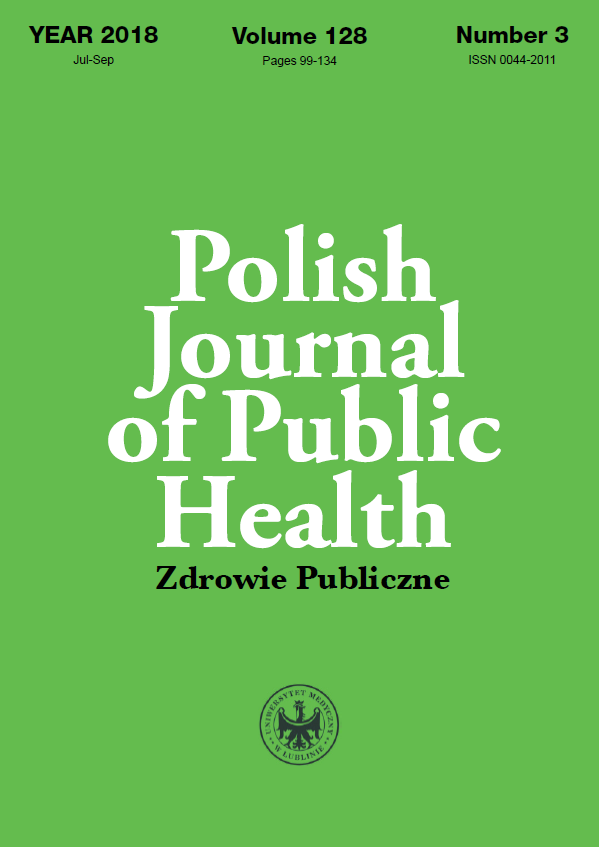Opinions of nursing and medical students before the end of their university education on their preparation for work with the dying patient
DOI:
https://doi.org/10.2478/pjph-2018-0024Keywords:
end-of-life care, nursing students, medical students, professional education.Abstract
Introduction. Well-implemented, holistic care of the dying patient requires appropriate qualifications from the medical personnel.
Aim. The aim of the study was to collect the opinions of nursing and medical students before the end of their professional education on their preparation to provide care to the dying patient.
Material and methods. The survey was carried out in a group of 213 medical and nursing students during their final year of professional education.
Results. Students were unable to clearly express their opinion on their preparation to provide care to patients at the end of their lives (87; 40.8%). Nursing students were more likely to perceive themselves as prepared for such care – 30 (26.7%) than medical students – 11 (10.9%). Statistically significant correlation was observed. A large group of the students (92; 43.2%) had never been present at the scene of a patient’s death during clinical classes. The majority of the respondents chose ‘definitely not’ (59; 27.7%) and ‘rather not’ (53; 24.9%) answers when asked if their university education had prepared them for work with patients at the end of their lives. Students considered their knowledge to be lacking mostly in areas such as coping with their own emotions in the face of a patient’s death (137; 64.3%); communicating with a dying person (119; 55.9%); providing care to the patient’s family (154; 72.3%); cooperating with the patient’s family (125; 58.7%).
Conclusions. Students of both majors are not certain about the level of their preparation to provide care to people at the end of their lives, nor about the extent to which their university education had introduced them to the specificity of care of a dying patient. The medical students were observed to exhibit higher statistical significance as compared to the nursing students. The university curriculum prepared the students to take care of the dying patient’s biological sphere, but did not prepare them to assume a holistic approach to care of the patient and his family
References
1. Kotlińska-Lemieszek A, Łuczak J. Opieka Paliatywna/Hospicyjna/Medy¬cyna Paliatywna. Now Lek. 2011;80(3):3-15.
2. Kübler-Ross E. Lęk przed śmiercią. In: E. Kübler-Ross. Rozmowy o śmierci i umieraniu. Poznań: Media Rodzina; 1979. p. 17-18.
3. Brien LA, Legault A, Tremblay N. Affective learning in end-of-life care education: the experience of nurse educators and students. Int J Palliat Nurs. 2008;14(12):610-4.
4. Shaw PA, Abbott MA. High-fidelity simulation: teaching end-of-life care. Nurse Educ Today. 2017;49:8-11.
5. Barrere C, Durkin A. Finding the right words: the experience of new nurs¬es after ELNEC education integration into a BSN curriculum. Medsurg Nurs. 2014;23(1):35-43.
6. Mott ML, Gorawara-Bhat R, Marschke M, Levine S. Medical students as hospice volunteers: reflections on an early experiential training program in end-of-life care education. J Palliat Med. 2014;17(6):696-700.
7. Anderson NE, Kent B, Owens RG. Experiencing patient death in clinical practice: Nurses’ recollections of their earliest memorable patient death. Int J Nurs Stud. 2015;52:695-704.
8. Dobrowolska B, Klukow J, Kręcisz K, et al. Kształcenie przeddyplo¬mowe pielęgniarek i lekarzy a ich przygotowanie do pracy z pacjentem umierającym. Psychoonkologia. 2008;2:37-44.
9. Dobrowolska B, Cuber T, Ślusarska B, et al. Analysis of the nurses’ and physicians’ opinion regarding their end-of-life education. J Palliat Med. 2011;14(2):126-7.
10. Von Guten Ch, Mullan P, Nelesen RA, et al. Development and evaluation of a palliative medicine curriculum for third-year medical students. J Pal¬liat Med. 2012;15(11):1198-206.
11. Jors K, Seibel K, Bardenheuer H, et al. Education in end-of-life care: what do experienced professionals find important? J Cancer Educ. 2016;31:272-8.
12. Jeffers S. Nurse faculty perception of end-of-life education in the clinical setting: a phenomenological perspective. Nurse Educ Pract. 2014;14:455-60.
13. Ferguson R, Cosby P. Nursing students’ attitudes and experiences toward end-of-life care: a mixed methods study using simulation. Clin Simul Nurs. 2017;13:343-6.
14. Pawłowski L, Buss T, Janiszewska J, et al. Wpływ kształcenia z zakresu medycyny paliatywnej na sposób postrzegania opieki paliatywnej przez studentów kierunku lekarskiego. Psychoonkologia. 2015;1:19-26.
Downloads
Published
Issue
Section
License
Copyright (c) 2019 Polish Journal of Public Health

This work is licensed under a Creative Commons Attribution-NonCommercial-NoDerivatives 3.0 Unported License.


